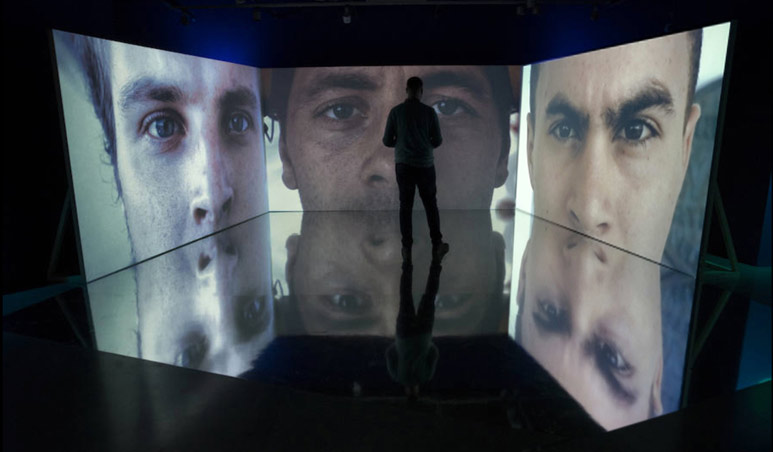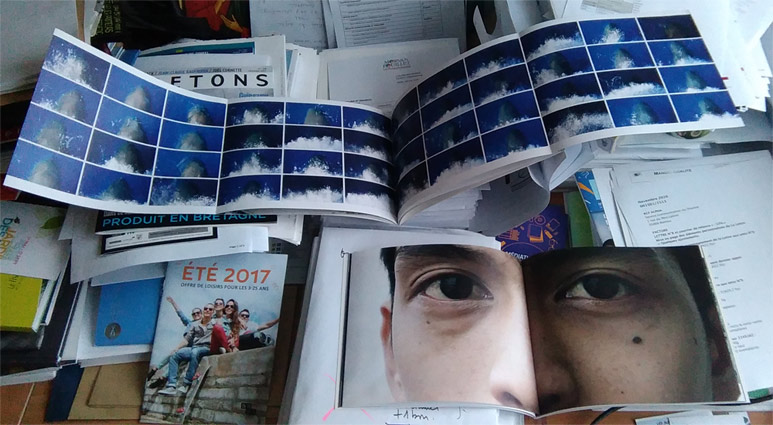
Hors pistes, Centre Pompidou, janvier 2017

Centre Pompidou Malaga, Espagne, avril 2017

Installation photographique ENSM

catalogue, 64 pages
|
|
Est-ce le port du Havre qui, de gauche à droite, s’en va, quitte son espace, entraînant avec lui ses grues, ses môles et ses quais ? Une mouette court et vole en sens inverse, remonte le bref espace entre un temps et l’autre, les secondes qui s’égrainent. Non, ce n’est qu’un effet ; il n’y a que l’oeil de l’artiste qui détermine l’espace et le temps. Dans un sens, dans l’autre, dans tous les sens du temps et du regard. Il va, il vient. Ici on traverse. Mais qu’est-ce que traverser : passer d’un point à un autre, mais dans quel sens ? Passer un pont, le traverser, une rue. Ici c’est l’eau, d’abord, d’où cet effet saisissant des lignes qui s’écartent et, mutuellement, se longent. Alors, c’est sans doute ça, comme si le port du Havre s’en allait. Comment traverse-t-on l’eau ? La traverser c’est peut-être perdre la tête, comme on perdrait les sens, ou du moins perdre sa dimension figée, et le regard glisse sur les choses qu’il voit sans les traverser. Ce traverser-ci, en fait, caresse avec violence, fixe tous les récits externes et internes du cargo, embarcadères et marchandises dans de lourds coffres, comme si un grand sultan partait pour un très long voyage. Qu’y a-t-il dans ces coffres ? Jamais on ne le saura, aucune écriture qui en dise l’essence. De même, l’oeil de la caméra traverse les regards des matelots, muets, jusqu’au bout, regards bleus d’acier ou marbres bruns, forêts lointaines, d’où aucun récit ne perce : la caméra traverse ces yeux qui se noient dans la pensée d’un infini sans mots. Traverser c’est enfin fendre l’eau : voilà, le navire fend l’eau, la traverse, la partage, la fait gicler et exploser en mousse, la fait frémir, à bord et à bas-bord, inlassablement il la fait jouir. Sensorialité : magie du bulbe, comme un éperon il enfonce les flancs de l’eau, marquant un vaste sillon qu’il ensemence. Magie de l’oeil de Nicolas Clauss qui sait saisir la beauté austère de ces frémissements brisant le cristal des vagues dans l’ivresse de joyeux abandons.
Jean-Paul Manganaro, préface du catalogue
----------------------------------------------------------------------------------
Is it the port of Le Havre, moving left to right, that is leaving, uprooting itself, taking with it its cranes and piers? A seagull darts and dips, going the other way, rewinding the brief lapse between one point in time and the other, the seconds that tick by. No, it is just an illusion; the artist’s eye alone determines space and time. One way, the other way, in all ways of time and perception. It comes, it goes. Here, it’s a crossing. But what is crossing: traversing from one point to another, but in what way? Traversing a bridge, a street. Here, it’s water, for a start, whence the striking illusion of lines moving away from and running alongside each other. So that must be it, as if the port of Le Havre was leaving. How does one traverse the ocean? In traversing it, perhaps one loses one’s mind, as one might one’s senses, or at least its rigid dimension, one’s gaze gliding over the things it sees without traversing them. This traversing of an ocean in fact caresses with violence, encompasses all the internal and external narratives of the cargo ship, ports of loading and goods stuffed inside bulky chests, as if some grand sultan was leaving on a very long journey. What is inside the chests? We shall never know, no text that will reveal their truths. Likewise, the eye of the camera traverses the looks of the seafarers, silent to the end, looks of a steely blue or marble brown, distant forests, that tell no stories: the camera traverses these eyes that are drowning in the thought of a wordless infinitude. Traversing the ocean is finally cutting through the water: that’s it, the ship is cutting through the water, parting it, making it splash and whipping it into foam, making it boil, above board and below board, tirelessly bringing it to orgasm. Sensoriality: the magic of the bulb, like a spur, gouging the water’s sides, leaving a huge furrow that it fills with its seed. The magic of Nicolas Clauss’ eye that captures the austere beauty of these spasms breaking the crystal waves in an intoxicating and joyful surrender.
Jean-Paul Manganaro
Expositions :
- Instants Vidéo, Marseille 2019
- Hors Pistes, Centre Pompidou Malaga 2017
- Centre Pompidou, Festival Hors Pistes, Paris 2017
Projections :
- VISUALCONTAINER (Festival Internazionale di Videoarte) - Milan 2018
- MIFF (Mumbai International Film Festival) - Mumbai 2018
- NOW & AFTER'18 (Autonomous Reality) - Moscou 2018
- Vidéoformes, Clermont Ferrand 2018
- "VISUAL POETRY", VIDEOBARDO BUENOS AIRE, Argentine
- Photophobia, Contemporary Moving Image Fest, Art Gallery of Hamilton - Canada 2018
- Ecole des Beaux-arts de Tel Aviv 2019
- Mandel Cultural Center, Tel Aviv JafoHa, Israel 2019
- National Gallery of Art Vilnius, Vilnius, Lithuania 2019
- Čiurlionis National Museum of Art, Kaunas, Lithuania 2019
|